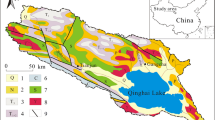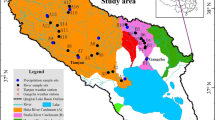Abstract
The Huangshui River, an important tributary in the upper reaches of the Yellow River, has been regarded as a mother river which gestates Qinghai civilization in China. This paper presents the results of hydrogen and oxygen isotopic and water chemical analyses for the summer and winter Huangshui River water to study its seasonal recharge and major dissolved solutes. Characteristics of hydrogen and oxygen isotopes suggest that precipitation in the Qilian Mountains is the original recharge of the Huangshui River. However, in winter, the basic flow of the Huangshui River only depends on spring recharge and spring water originates from melt and infiltration of bottom layer glaciers. In summer, besides spring water, much rainfall directly recharges the Huangshui River, thus making its flux increase greatly. Water chemistry shows that the processes affecting dissolved solutes in the Huangshui River are also different between summer and winter. In summer, major ions in the river water are dominantly derived from carbonate and evaporate dissolution and anthropogenic inputs. In winter, carbonate dissolution decreases greatly while anthropogenic inputs play a much more important role for dissolved solutes in the river. Hence, further measures should be taken to lay stress on the winter Huangshui River water in order to protect the environment of the Huangshui River and reduce effects of dissolved solutes on, or prevent their pollution toward the upper Yellow River. Moreover, some measures also need to be introduced to prevent the possibility of water eutrophication caused by agricultural activities or stock raising in summer.
Similar content being viewed by others
References
Carol Kendall and Jeffrey J. McDonnell (1998) Isotope Tracers in Catchment Hydrology [M]. Elsevier, Amsterdam, USA.
Chetelat B., Liu C., Zhao Z., Wang Q., Li S., Li J., and Wang B. (2008) Geochemistry of the dissolved load of the Changjiang Basin rivers: anthropogenic impacts and chemical weathering [J]. Geochim. et Cosmochim. Acta. 72, 4254–4277.
Cécile Picouet, Bernard Dupré, Didier Orange, and Michel Valladon (2002) Major and trace element geochemistry in the upper Niger River (Mali): physical and chemical weathering rates and CO2 consumption [J]. Chemical Geology. 185(1–2), 93–124.
Chen J., Wang F., Xia X., and Zhang L. (2002) Major element chemistry of the Changjiang River (Yangtze River) [J]. Chemical Geology. 187, 231–255.
Chen J.S. and Wang C.Y. (2009) Rising springs along the Silk Road [J]. Geology. 37, 243–246.
Clark I.D. and Fritz P. (1997) Environmental Isotopes in Hydrogeology [M]. Lewis Publishers, Boca Raton, USA.
Craig H. (1961) Isotopic variations in meteoric waters [J]. Science. 133, 1702–1703.
Dawson T.E. and Ehleringer J.R. (1998) Plants, isotopes, and water use: a catchment-scale perspective. In Chemical fingerprints of hydrological compartments and flow paths at La Cuenca, western Amazonia (eds. Elsenbeer H., Lack A., and Cassel K., 1995) [J]. Water Resources Research. 31, 3051–3058.
Gibbs R.J. (1970) Mechanisms controlling world water chemistry [J]. Science. 170, 1088–1090.
Hu M.H., Stallard R.F., and Edmond J.M. (1982) Major ion chemistry of some large Chinese rivers [J]. Nature. 298, 550–553.
Ingraham N.L. and Matthews R.A. (1988) Fog drip as a source of groundwater recharge in northern Kenya [J]. Water Resources Research. 24, 1406–1410.
Li Jingying and Zhang Jing (2005) Chemical weathering processes and atmospheric CO2 consumption of Huanghe River and Changjiang River basins [J]. Chin. Geogr. Sci. 15, 16–21.
Li Siyue and Zhang quanfa (2009) Geochemistry of the upper Han River basin, China, 2: Seasonal variations in major ion compositions and contribution of precipitation chemistry to the dissolved load [J]. Journal of Hazardous Materials. 170(2–3), 605–611.
Lauriol B. and Clark I.D. (1993) An approach to determine the origin and age of massive ice blockage in two Arctic caves [J]. Permofrost Periglacial Processes. 4, 77–85.
Matthew S., Lachniet, and William P. Patterson (2002) Stable isotope values of Costa Rican surface waters [J]. Journal of Hydrology. 260, 135–150.
Meybeck M. (1987) Global chemical weathering of surficial rocks estimated from river dissolved loads [J]. Am. J. Sci. 287, 401–428.
Piper D. Z., Steve Ludington, Duval J.S., and Taylor H.E. (2006) Geochemistry of bed and suspended sediment in the Mississippi River system: Provenance versus weathering and winnowing [J]. Science of the Total Environment. 362(1–3), 179–204.
Stallard R.F. and Edmond J.M. (1983) Geochemistry of the Amazon. 2. The influence of geology and weathering environment on the dissolved load [J]. Geophys. Res. 88(C14), 9671–9688.
Stallard R.F. and Edmond J.M. (1987) Geochemistry of the Amazon. 3. Weathering chemistry and limits to dissolved inputs [J]. Geophys. Res. 92(C8), 8293–8302.
Wang Ninglian, Zhang Shibiao, He Jianqiao, Pu Jianchen, Wu Xiaobo, and Jiang Xi (2009) Tracing the major source area of the mountainous runoff generation of the Heihe River in northwest China using stable isotope technique [J]. Chinese Sci. Bull. 54, 2751–2757.
Xu Z.F. and Liu C.Q. (2007) Chemical weathering in the upper reaches of Xijiang River draining the Yunnan-Guizhou Plateau, Southwest China [J]. Chemical Geology. 239(1–2), 83–95.
Zhang C.S., Wang L.J., Zhang S., and Li X.X. (1998) Geochemistry of rare earth elements in the mainstream of the Yangtze River, China [J]. Applied Geochemistry. 13, 451–462.
Zhang Jing, Huang Weiwen, and Liu Mingguang (1990) Drainage basin weathering and major element transport of the Chinese rivers (Huanghe and Changiiang) [J]. J. Geophys. Res. 95(C8), 13277–13288.
Zhou S.Q., Nakawo Masayoshi, Sakai Akiko, Matsuda Yoshihiro, Duan K.Q., and Pu J.C. (2007) Water isotope variations in the snow pack and summer precipitation at July 1 Glacier, Qilian Mountains in Northwest China [J]. Chinese Sci. Bull. 52, 2963–2972.
Author information
Authors and Affiliations
Corresponding author
Rights and permissions
About this article
Cite this article
Tan, H., Zhou, H., Rao, W. et al. Geochemical constraints on seasonal recharge of water and major dissolved solutes in the Huangshui River, China. Chin. J. Geochem. 31, 155–164 (2012). https://doi.org/10.1007/s11631-012-0562-6
Received:
Accepted:
Published:
Issue Date:
DOI: https://doi.org/10.1007/s11631-012-0562-6




